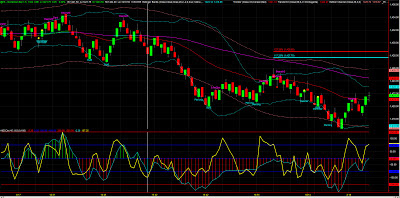What do you consider to be a reasonable yearly percentage return on account from day trading alone (ie excluding income from your options trading etc) after commissions etc?I have written about this in the past, particularly in the early days of the blog in 2010 so go back and read those comments too if this topic is of interest.
Firstly, let me say that discretionary trading is not a return on an investment. Discretionary trading is not investing. It's a business like any other. So believing that "I have $30,000 of capital and I want to earn 30% a month" is not the way to look at discretionary trading. If you were using an algo to trade fully automatically then things are more passive and the way you looked at trading would be a bit different to discretionary trading.
But the question, in a slightly different form, needs to be answered. If someone wants to become a discretionary trader then he needs to create a business plan, a trading plan, and that means looking at return not on capital put the return from exertion and risk.
Now, we need to define what we do:
- what we trade
- how many hours and how many days a month are we doing it
- what is the risk per trade - VERY important subject I'll post about separately
- what the criteria for entering and exiting trades are.
The next stage is to paper trade the plan so that it can be validated in real time. paper trading is not the same as live trading due to the vagaries of fills and the psychological impact on a trader but if you can't get the results you want by paper trading then it's highly unlikely that you'll achieve them live so this step is important unless you want to risk money on the unknown.
Whatever your methodology, you can only earn what the market gives you. Market activity varies as does volatility. You cannot predict either in the short term so the more paper trading stats you have, the more accurate your calculations of future stats will be - large sample size.
How much can be earned is different for every trader and his trading plan.
Let me draw attention to the CFTC disclaimers relating to past performance not being a guarantee of future profitability and the unreliability of hypothetical trades.
Now let's look at the specifics. You have done your back testing and/or back testing and paper trading and you see that:
- I have $30,000 in my trading account
- I trade 4 hours a day
- I risk $1,000 per trade
- I trade 4 times a day and 19 days a month
- I trade about 76 times a month (#4 = 19 times 4)
- My win rate is 73%
- My average win is $573 after commissions
- My average loss is $842 after commissions
- My projected profitability over the long term is therefore:
Amount won a month = 55.46 x $573 = $31,778.58
Losing trades per month = 76 x 0.27 = 20.52
Amount lost per month = 20.52 x $842 = $17,277.84
Nett amount earnable per month (projected) = $31,778.58 - $17,277.84
= $14,500.74
Let me point out that if the same trader worked for 6 hours instead of 4 hours at the same level of profitability then with the same $30,000 he would earn $21,751.11.
These numbers assume that there is a tested trading plan and that the trader will stick to the trading plan. No trader I know, including me, sticks 100% to a trading plan.
So now cut these projections into half.
As you can see, you are not getting a return on your capital but have a business that is capitalised so that with the trader's exertion and expertise, profits are made. The capital does not earn the money. The trader does.




















